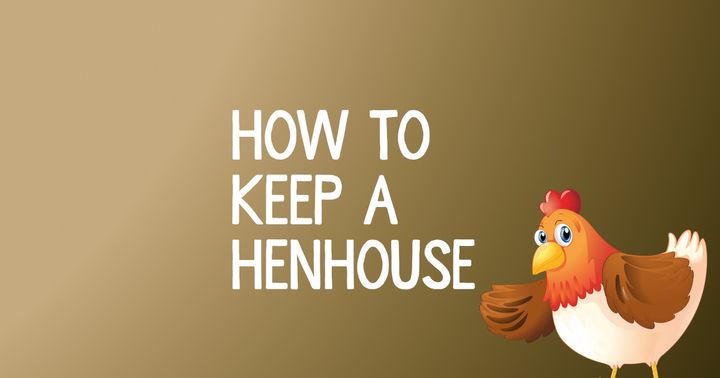How To Keep (And Look After) A Henhouse


There are two important items concerning the hen house:
Table of Contents:
To get quickly to your hen house, you should build it as close as possible to your house; on the other hand, it should be built up as far from your neighbors as possible, so that they don’t feel disturbed about the sounds and the smell of the chickens.
Spaciousness
Firstly you should think about how many chickens you want to keep because more chickens need more space and less chickens less.
| Number of chickens | Spaciousness in m2 | size of windows in m2 |
|---|---|---|
| 3 | 1 | 0,2 |
| 5 - 7 | 2 | 0,4 |
| 8 - 10 | 3 | 0,6 |
| 12-15 | 5 | 1,0 |
| 20 - 25 | 8 | 1,5 |
A hen house usually looks like a garden house. But if you only want to keep three hens you can also build a smaller one with only 1 square m area and a height of 80 cm. The door also serves as a window and is made of glass or Perspex. The roof is removable for comfortable cleaning of the house. You should build it a few decimeters over the ground to avoid wetness seeping in from the ground. With a chicken ladder they can go outside.
If you keep more than three chickens you should build a larger hen house which you can enter yourself. Follow this link to se a proposal.
If you decide to keep Bantams you can keep 30 % more chickens in the set space.
If you want to keep Bantams, you can keep 30 % more chickens in the set spaciousness.
Condition
Now you should think about the raw materials, wood or stone. Most people build a wooden hen house, especially with a smaller number of chickens, because it is easier and cheaper to build.
The hen house should be warm and bright and it should have a good air-condition, but no draft. The temperature is not that much important because the laying performance is especially influenced by brightness and not by warmth. However, the temperature should not sink under 5 °C, because then the eggs lose their capacity for development. So you should construct double walls with insulating material in between.
The outside wood should be painted several times with a protective coat so that won’t rot. The roof should be covered with roofing felt.
The ground should consist of wood or concrete. Concrete saves the hen house pretty well against mice and rats compared with a wooden floor where those animals can easily invade the house. But I don’t mind about five or six mice living in the interior of the wall because they actually don’t eat very much grain. Using the chemical mace against them would cost more.
The windows should point to the east so that there is enough light in the hen house in the morning, which improves the laying performance. In the summer time you can replace the window with a wire netting to get fresh air into the hen house. But anyway you should avoid draft.
The height of the hen house should be about two meters so that you can walk inside comfortably. The door should be at least 80 cm wide to get inside with a handcart, too. The exit for the chickens should be a small door, about 25 cm wide and 40 cm high so that they won’t scratch out the straw on the floor. That's also why you should keep the front door closed the whole day.
In the night you have to lock your hen house, so that no wild animals like foxes or martens can enter it and kill the chickens.
For the night chickens need a perch where they can sleep on. You should position them in the upper part of the hen house because the chickens like sitting high. The perch should be well-rounded and about 5 cm in diameter. One chicken needs about 20 – 30 cm room on the perch. So there always have to be enough perches for your number of chickens.
Below the perches you should install a board to collect the excrements. So you prevent the straw on the floor from getting dirty and you can clean the hen house more easily. The board should be waterproof.
If you want to have it even cleaner, fix a wire netting so that the chickens do not come into contact with their excrements.
The hens need nests for laying their eggs. You may start with lightweight wooden boxes with a filling of hay. You can put a few plaster eggs into the nests; the hens will readily accept them. The chickens will like your nests even more if you hang them up on a dark place in the hen house. My own hens prefer sitting right under the roof.
But the problem with these nests is, that some hens begin to eat the eggs and spread the white of the egg all over the nest. Everything gets dirty and because of the adhesive white of the egg, you won’t be able anymore to brood the other eggs.
Even if you don’t have any hens which like eating their own eggs, many of them get broken if two hens sit together on one nest.
That’s why a special kind of nest was constructed in Germany the so-called Europe nest. Some mechanism closes the nest when one hen has gone inside, and the egg leaves the nest through a whole in the bottom right after the hen has laid it. So both the nest and also the eggs remain clean. Well, that kind of nest is not that comfortable for the hens as are nest made of hay but after a few days they usually accept it.
But if you want to breed chickens on a larger scale you need another kind of nest. After the hen has entered it, the door closes automatically and the hen cannot leave it without the help of the breeder. So the breeder knows which hen laid which egg, which is very important for breeding chickens.
You need one nest for approx. five hens. If you only keep five chickens, it is better to install two nests.
If you want to get a load of eggs even in the winter you should install lights and have them switched on for about 15 hours a day. But you should not use a neon light, because it makes the chickens nervous.

This is an example of a hen house for 10 – 12 chickens. Under the perch there is a board. You should not mount the perches close to the window because it is to bright for the chickens in the morning.

